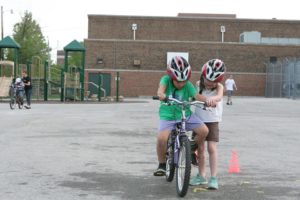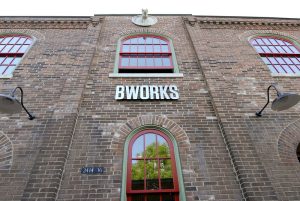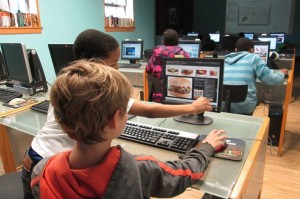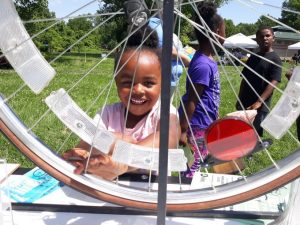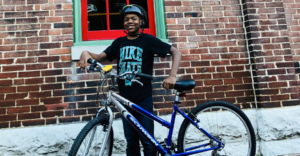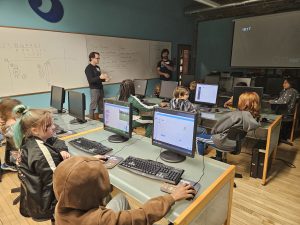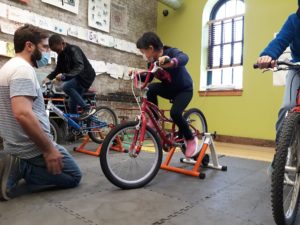Bworks sent the following letter last week regarding bb120 and the $40 million dollars being used to address traffic violence.
Greetings, Mayor Jones, Alderman Bosley and Mr. Boyd.
We have been so pleased in recent months to hear that your administration is eager to make our streets safer, “no matter how residents choose to get around — walking, biking, using public transit, or driving.” It’s especially encouraging to see Board Bill 120 beginning its route through the local legislative process this fall, with significant ARPA funds intended to help accomplish this priority of yours.
As an organization based around encouraging youth and families to get on bicycles, we have struggled for years with how the St. Louis community continues to approach our failures to protect our most vulnerable road users. BWorks is the only organization dedicated to offering education to our youth around this transportation mode.
We are writing because we strongly believe BB120 needs further attention, particularly around road-user education and driver accountability, in order to have the best chance of truly improving the chances of pedestrian and cyclist safety in our shared city.
We hope that this $40 million in proposed funding is truly utilized to address this problem pertaining to cyclists and pedestrians, dozens of whom have been killed in recent weeks and months, and that it is not lost in the millions upon millions of dollars we spend annually on streets.
We are asking that 1% of the $40 million in this bill goes to education programs and another 1% goes to special enforcement pertaining to cyclists and pedestrian issues.
Below, we offer suggestions of what education and enforcement could and should look like. These are extensive subjects, and we hope we can continue with your help to develop various ideas within this theme of education and enforcement.
- Educate families impacted by crashes on what happens next and how to navigate recovery: Hopefully all victims will only go through this once in their life, and we should not leave them to navigate this process alone. Working with these families in a time of need to understand next steps is a huge piece of healing.
- Establish a hit-and-run reward fund: This not only can help our police with progress on solving these crimes but also helps keep these stories — of people being left to die in the road — higher on the media radar, communicating the personal stories of these crashes to the general public.
- Enforce traffic laws: The ways in which we hold drivers accountable to our most basic rules of the road can be varied and multiple; it’s not simply police pulling people over, for example. We are eager to get creative about this piece of the puzzle and to pair it with education as well.
- Educate police department members about crash reports: In both of the recent crashes affecting members of BWorks’ extended family, there were multiple errors that ultimately caused delay and longer fights over responsibility. We worked with these victims to address these errors, collecting witness information and even video of the crashes. We need those issuing the reports to understand better the effects of their actions.
- Educate young people: East-West Gateway data shows that 10 to 14-year-olds are the number-one age group who are hit by cars (245 individuals). By comparison, only 112 pedestrians were struck in the 30-34 age group. Education in schools and on the community level is extremely important and worthy of St. Louis City’s investment.
We are very much in favor of the planned infrastructure improvements focused on pedestrians and cyclists, and recognize the need for significant funds to be devoted to that piece of this challenging puzzle. But without significant investment in street-safety-related education, as well as driver enforcement/accountability, alongside important physical changes to our streets, vulnerable St. Louisans will continue to be killed and maimed by reckless drivers. We are not alone in this belief. The U.S. Department of Transportation and even our local East-West Gateway have both stated that education and enforcement are key, that engineering alone cannot solve this problem.
Just in the past two months, St. Louis BWorks has unfortunately had two members of our local nonprofit’s extended family seriously injured by local drivers.
One of those victims is a recent Earn-A-Bike program graduate, who is now struggling to complete his classwork and other tasks after suffering a concussion after being hit in a crosswalk. This driver added insult to injury by leaving the student after the crash.
The other is a staff member’s wife, who spent a week in the hospital and is now losing out on months of income as she continues rehab at home.
BWorks is focused on helping the children and teens of St. Louis dream big, care about the world around them and explore new possibilities through experiential learning. In 2022 alone, we’ve guided 51 groups of children through our free, multi-week Earn-A-Bike, Learn-To-Ride and Earn-A-Computer programs. We don’t carry out this mission just because it’s a nice thing to do; we do this work because we truly believe in the power of education — and that a world where all children have the chance to thrive is one worth building.
And so along with this unprecedented investment in pedestrian and cycling infrastructure, Mayor Jones, we are asking that you and the Board of Aldermen not neglect the opportunity to begin to address the other key pieces of this puzzle, if we truly seek to improve street safety, particularly for young people.
Thanks so much for considering our request, and we’re always happy to discuss this with you and other local elected officials about where we go from here. We look forward to discussing this with you.
Patrick Van Der Tuin, executive director, Evie Hemphill, programs director, St. Louis BWorks
For your consideration,
While crashes involving pedestrians are spread somewhat evenly across the city, residents north of 40 are not surviving (Red Dots). We would also like to point out that downtown and the Central West End as expected have higher crash reports (Blue Dots). But the Fox park area, as well as Walnut Park West, Wells Goodfellow, and others show higher density in residential areas.
Red dots are fatal, Blue dots are injury. Data from Mo state highway dept.

